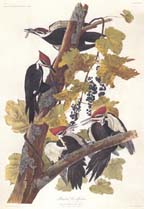|
The Ivory-Billed Woodpecker
Campephilus principalis .... Natural
History Facts About the Ivory-billed Woodpecker (adapted from information
provided by the Nature Conservancy).
The ivory-billed woodpecker is believed
to have ranged through
swampy forests along
the lower Mississippi valley from Arkansas (where the most recent
sightings have been confirmed) to Louisiana, with some 1800s reports in
Kentucky,  Missouri and Oklahoma. John James Audubon reported ivory-bills as
far north as the junction of the Ohio and Mississippi rivers around 1825. Missouri and Oklahoma. John James Audubon reported ivory-bills as
far north as the junction of the Ohio and Mississippi rivers around 1825.
Their brilliant white bills contrasted finely with
the black of their general plumage. They were noisy but wary, and they
seemed to me to set off the wildness of the swamp as much as any of the
beasts they chase.
Theodore Roosevelt
1907
- Description of the ivory-billed
woodpecker:
Averaging about 20 inches in length, the Ivory-billed is
among the world’s largest woodpeckers. Only the imperial woodpecker of
Mexico, now thought by many to be extinct, is larger. The ivory-bill is
frequently mistaken for the smaller pileated woodpecker.
Birders can distinguish the two by the location of the white wing
feathers: the full-width white patch in the ivory-bill’s trailing wing
feathers (when seen from above) folds to form a white “V” on its back
when the bird is perched. Males have a prominent scarlet crest; the
female’s crest is black. Both male and female pileated woodpeckers have
the red crest.
The Audubon painting above is the ivory-billed. below
is the pileated woodpecker. These two prints also illustrate an
interesting variation in the printing of Audubon prints... the above print
is produced exactly as Audubon painted it. In later printings (seen in the
pileated print), the printer added his own embellishments hoping to make
the prints more saleable!!
- Comparison's
between the ivory-bill and the pileated:

Flight: The Ivory-bill is swift and straight.
Its stiff wing feathers make it an especially loud flyer. The pileated is
slower, with a swooping, nearly silent, flight.
A Nature Conservancy story notes that people who saw the impressive
ivory-bill in flight could be forgiven for shouting, “Lord God, what a
bird!” — explaining why the ivory-bill is also known as the
Lord God Bird.
I personally ran across someone who showed his
Grandmother on the Pearl River in Louisiana the painting of the
ivory-billed and she knew immediately what it was... "A WOOD TURKEY,
and very good eating!"
Ornithologists transcribe the call of the ivory-bill
as “kent, kent, kent.” The double-rap... “BAM-bam”
of their bills pounding on wood contrasts with the sound of the pileated
which consists of a stacato of sound which accelerates and carries great
distances in the woods.
- The ivory-bill
may live as long as 30 years. It's bill continues to grow from its thick
skull throughout its life as it is worn down by continual pounding on
trees.
- Habits and habitat:
Ivory-bills are believed to mate for life and share the duties of
protecting eggs and feeding their young. The Nature Conservancy
believes that a pair of
ivory-bills is estimated to need six square miles of uncut forest, roughly
36 times as much territory as pileated woodpeckers require! Ivory-bills
make nest holes 40 feet or higher above ground level (usually oval-shaped openings between
four and six inches in size, extending 20 inches or more down into the
tree). Pileated woodpeckers will excavate huge holes that are much lower
in the trees.
- Food source of the ivory-billed
woodpecker:
Beetle larvae are the primary food source for ivory-bills. As the larvae bores through the bark to feed on the sap wood beneath,
ivory-bills will use their elongated beaks to pry bark from the trees and
expose the larvae.
Ivory-bills are usually the first woodpeckers
to search out the larvae. Later, other woodpecker species will excavate deeper regions of the dying
trees for insects found there. Thus, ivory-bills do not, for the most
part, compete for insect food with other woodpeckers, and their
territories can overlap.
Field Markings of the more
Common Pileated Woodpecker:

Click here to see the Los Angeles
Times report of the April 28th, 2005, sightings of the Ivory-bill or
visit the #1 Mississippi River Birding site on
www.greatriver.com
Click here for
AUDIO RECORDINGS from the US FISH and WILDLIFE SERVICE archives.
[
Return to Mississippi River Home Page
]
[ Become a
Subscriber! ]
[ What's New on
greatriver.com ]
[ Find your river
travel interest group BBS ]
[Visit our Travel Directory]
[Browse our
Travel INSIGHT Features]
[Sign
Guestbook ]
[ Travel Insight
Features ]
[ River Guides &
Charts ]
[Advertising Info
]
Visit our Mississippi
River Bookstores!
Great Gifts for travelers and River Buffs!
|
 Missouri and Oklahoma. John James Audubon reported ivory-bills as
far north as the junction of the Ohio and Mississippi rivers around 1825.
Missouri and Oklahoma. John James Audubon reported ivory-bills as
far north as the junction of the Ohio and Mississippi rivers around 1825.

